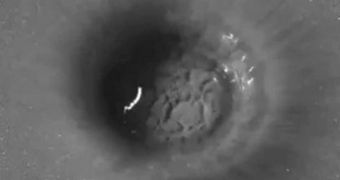The behavior of water is notoriously difficult to predict, but within such research lies the secret to understanding life on other planets, and even in the Earth-based fossil record. Japanese investigators at the Kyushu University in Fukuoka, led by expert Hiroaki Katsuragi, have been conducting studies into how water drops behave when hitting specific surfaces, in order to clear up this mystery. Throughout their research, the experts allowed drops of various sizes to fall onto targets made of certain materials, and then looked at the impact crater, and at the phenomena that took place as the impact occurred.
In a scientific paper published in the latest issue of the top-rated journal Physical Review Letters, the research team details its findings. The scientists detail how they let water drops fall on grains of silicon carbide from heights ranging between 10 and 480 millimeters. The grains themselves were of varied sizes, ranging from 4 to 50 microns. The team meticulously measured the depth, and width of each resulting crater, as well as other traits. Throughout the work, the water drops that impacted the samples were around 4.8 millimeters in diameter, PhysOrg reports.
In the case of low-speed water drops, the team determined that the water did not immediately produce a crater. In other words, it did not act on the top grain layers immediately. However, a crater was produced in the end, as the pressure of the drop compressed the layers beneath the ones that were impacted. The resulting cylindrical craters were all about 1.5 millimeters in diameter, and they were dubbed sink craters. It was additionally discovered that varying the size of the target, and placing larger grains within the impact sample, resulted in considerably shallower craters.
Things were very different in the case of high-speed impacts. The Kyushu University team discovered that the water drops produced a convex bump on the target that was observably higher than the original level of the surface. Additionally, scientists found that no additional compression appeared after the drop struck the grains. Using the data collected from these studies, Katsuragi was able to derive a mathematical model of the experiment. The calculations are able to predict the diameter of a crater produced by a drop of water, depending on the density of the granular material placed in the target.

 14 DAY TRIAL //
14 DAY TRIAL //